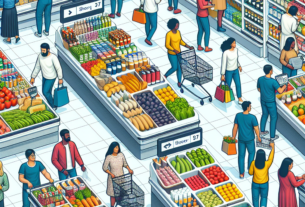The State of the Global Grocery Retail Industry in 2025: Trends, Challenges, and Opportunities
In 2025, the global grocery retail industry is undergoing a significant transformation, driven by changing consumer preferences, technological advancements, and competitive pressures. Supermarket giants are increasingly investing in digital-first strategies to stay ahead of the curve and meet the evolving needs of their customers. This report will examine how these supermarket giants are adapting to the digital age and the implications for the industry as a whole.
Market Overview
The global grocery retail industry is a massive market, with total sales exceeding $5 trillion in 2025. The industry is highly competitive, with a few major players dominating the market. Supermarket giants such as Walmart, Amazon, and Alibaba have a significant market share and are constantly seeking ways to innovate and differentiate themselves from the competition.
Financial Performance
In terms of financial performance, supermarket giants continue to post strong numbers, with revenue growth averaging around 5% per year. Walmart, the world’s largest retailer, reported total revenue of $550 billion in 2024, a 6% increase from the previous year. Amazon, a major player in the grocery retail space, saw its grocery sales grow by 20% in 2024, reaching $50 billion.
Market Share
Supermarket giants control a significant portion of the global grocery retail market. Walmart, for example, has a market share of around 15%, making it the largest player in the industry. Amazon, with its Whole Foods acquisition, has also been gaining market share, particularly in the online grocery segment. Alibaba, the Chinese e-commerce giant, has a dominant position in the online grocery market in China, with a market share of over 50%.
Digital-First Strategies
Supermarket giants are increasingly investing in digital-first strategies to enhance the customer experience, streamline operations, and drive growth. These strategies encompass a wide range of initiatives, including e-commerce platforms, mobile apps, digital marketing, and data analytics.
E-commerce Platforms
One of the key areas of investment for supermarket giants is e-commerce platforms. Walmart, for example, has been expanding its online grocery delivery and pickup services, allowing customers to order groceries online and have them delivered to their doorstep or pick them up at a nearby store. Amazon has also been investing heavily in its online grocery business, offering a wide selection of products and fast delivery options through its Prime membership program.
Mobile Apps
Mobile apps are another important tool for supermarket giants to engage with customers and drive sales. These apps allow customers to browse products, place orders, and receive personalized recommendations based on their shopping habits. Walmart’s mobile app, for example, offers features such as in-store navigation, digital coupons, and mobile payments to enhance the shopping experience.
Digital Marketing
Digital marketing plays a crucial role in supermarket giants’ digital-first strategies. By leveraging social media, email marketing, and online advertising, these companies can reach a wider audience and drive traffic to their e-commerce platforms. Targeted promotions and personalized offers can also help increase customer loyalty and retention.
Data Analytics
Data analytics is another area of focus for supermarket giants, as they seek to harness the power of big data to make informed business decisions. By analyzing customer behavior, preferences, and purchasing patterns, these companies can optimize their product offerings, pricing strategies, and marketing campaigns to drive growth and profitability.
Future Plans
Looking ahead, supermarket giants are expected to continue investing in digital-first strategies to stay competitive in the evolving grocery retail landscape. Key areas of focus include expanding e-commerce capabilities, leveraging artificial intelligence and machine learning technologies, and enhancing the omnichannel shopping experience.
Expanding E-commerce Capabilities
Supermarket giants will continue to expand their e-commerce capabilities, investing in infrastructure, technology, and logistics to meet the growing demand for online grocery shopping. Same-day delivery, curbside pickup, and subscription services are likely to become more widespread, offering customers greater convenience and flexibility.
Leveraging AI and Machine Learning
Artificial intelligence and machine learning technologies will play a crucial role in supermarket giants’ future plans, enabling them to personalize the shopping experience, optimize inventory management, and improve operational efficiency. AI-powered chatbots, recommendation engines, and predictive analytics will help drive sales and enhance customer satisfaction.
Enhancing Omnichannel Experience
The integration of online and offline channels will be a key focus for supermarket giants, as they aim to provide a seamless shopping experience across all touchpoints. Omnichannel initiatives such as click-and-collect, buy online pick up in-store (BOPIS), and digital loyalty programs will be prioritized to drive customer engagement and loyalty.
In conclusion, supermarket giants are making significant investments in digital-first strategies to adapt to the changing landscape of the grocery retail industry. By leveraging e-commerce platforms, mobile apps, digital marketing, and data analytics, these companies are able to enhance the customer experience, drive growth, and stay ahead of the competition. Looking ahead, continued investment in e-commerce capabilities, AI and machine learning technologies, and omnichannel initiatives will be key to success in the future.



